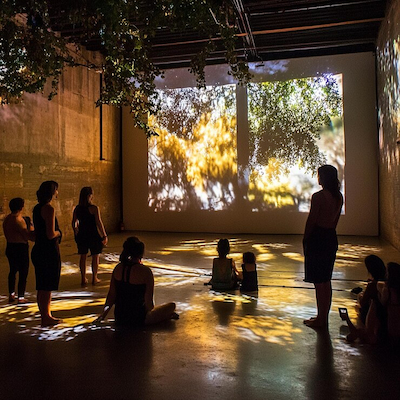
Street theater is an artistic expression that stands out for its ability to bring art outside conventional spaces, breaking barriers and democratizing access to culture. This form of theater takes place in squares, streets, and other public spaces, allowing anyone, regardless of social status, to experience theatrical performances. With a long history that dates back to popular and folkloric traditions, street theater constantly reinvents itself, adapting to contemporary demands and the social contexts in which it is inserted.
In addition to being a form of entertainment, street theater plays a crucial role in promoting social engagement and cultural resistance. By addressing relevant and pressing social topics, this form of art not only entertains but also provokes reflection and dialogue on issues such as inequality, human rights, and cultural identity. In this way, street theater becomes a powerful tool for raising awareness and fostering social mobilization, contributing to the development of more cohesive and supportive communities.
How Theatrical Interventions in Public Spaces Work
Theatrical interventions in public spaces are designed to be accessible and impactful, using the urban environment as a stage and passersby as the audience. Street theater groups often work with a repertoire that directly relates to the local reality, creating plays that reflect the experiences and challenges of the community. This closeness to the audience is fundamental, as it allows the stories told to resonate more intensely and meaningfully.
Actors and actresses who perform in street theater are usually trained to quickly adapt to environmental conditions, using resources like improvisation and audience interaction. This flexibility is essential, as interventions can happen anywhere, from a busy square to a quiet street. The use of visual and auditory elements, such as colorful costumes and live music, also enriches the experience, making it more engaging and memorable.
Additionally, theatrical interventions often encourage audience participation. This might include inviting people to join the actors on stage or to share their own stories and experiences. This interaction not only makes the performance more dynamic but also creates a sense of community and belonging, reinforcing the idea that everyone plays a role in building the collective narrative.
Lastly, theatrical interventions in public spaces are a form of cultural resistance, challenging established norms and standards. By occupying streets and public spaces, artists demand visibility and create space for voices that are often silenced. This action not only celebrates cultural diversity but also prompts questions about power, identity, and social justice, transforming the act of watching a play into an experience of reflection and transformation.

Advantages of Street Theater: Accessible Art and Social Engagement
Street theater offers a number of advantages that go beyond entertainment, standing out as a form of accessible art and a tool for social engagement. One of the main advantages is the democratization of culture, allowing people from different backgrounds and social classes to access artistic experiences. By performing in public spaces, street theater removes financial and geographical barriers, ensuring that art is within everyone’s reach.
Another significant advantage of street theater is its capacity to promote social engagement. The plays often address relevant and urgent themes such as inequality, racism, violence, and human rights. By bringing these issues to the forefront, theater provokes reflection and dialogue among spectators, encouraging awareness and mobilization around social causes. This interaction between art and activism helps to shape a more critical and engaged society.
Additionally, street theater strengthens community bonds. Theatrical interventions often involve the participation of local residents, creating a sense of belonging and identity. By telling stories that reflect the community’s experiences, theater becomes a space of welcome and exchange, where people can recognize and connect with each other. Building social ties is fundamental to strengthening the community and promoting a more supportive environment.
Lastly, street theater stimulates creativity and popular expression. By encouraging the active participation of the audience and collaboration between artists and spectators, this form of art opens space for new voices and narratives. This not only enriches the cultural scene but also promotes an environment where creativity can flourish, allowing people to express themselves freely and share their stories in an authentic way.
How Street Theater Promotes Inclusion and Cultural Resistance
- Creating Spaces for Dialogue and Reflection: Street theater serves as a catalyst for dialogue, creating an environment where people can openly and accessibly discuss social and cultural issues. Performances often address controversial topics, allowing the audience to reflect on their own experiences and opinions.
- Accessibility for All Audiences: By performing in public spaces, street theater ensures that people of all ages and backgrounds can participate. There is no need for expensive tickets or formal theater halls; art is brought directly to the people, making it truly inclusive.
- Strengthening Community Through Art: Theatrical interventions often involve collaboration with local artists and community members, strengthening social bonds and promoting a sense of belonging. This collaboration helps to build collective identity and foster solidarity among residents.
- Encouraging Creativity and Popular Expression: Street theater encourages creativity, allowing artists and community members to explore new forms of expression. This creative freedom is fundamental for cultural development and the appreciation of local traditions.
- Connection with Relevant Social Issues: Street plays often address social issues that directly affect the community, such as poverty, racism, and gender inequality. This not only educates the audience but also mobilizes them to take action, fostering greater civic engagement.
- Support for Local Artistic Movements: Street theater contributes to the strengthening of the local arts scene, encouraging the creation of new groups and cultural initiatives. This not only enriches the region’s cultural offerings but also helps to preserve and value local artistic traditions.
Street theater, therefore, is not just a form of entertainment, but a powerful tool for inclusion and cultural resistance. By promoting dialogue, accessibility, and popular expression, this form of art plays a crucial role in building more just and supportive communities.

Did You Enjoy Learning About Street Theater: Accessible Art, Social Engagement, and Resistance?
Street theater is a vibrant and dynamic form of art that not only entertains but also educates, inspires, and mobilizes. It reminds us that culture is not confined to elite institutions—it lives and breathes in the streets, among the people. In this open, public arena, art becomes a powerful vehicle for resistance, inclusion, and social change. Street theater invites everyone, regardless of background or circumstance, to participate in a shared human experience where stories are told, voices are amplified, and communities come together.
If you found this topic interesting, there is a whole world of performances, collectives, and movements waiting to be discovered. Attend a show in your city, engage with local artists, or even try participating in a community-led performance. Through street theater, you’ll not only witness creativity in its rawest form, but you’ll also feel the heartbeat of society, expressed through rhythm, voice, and movement. Let this art form inspire you to see public space—and your own voice—as a stage for connection, change, and imagination.
Frequently Asked Questions
What is street theater?
Street theater is a form of art that takes place outdoors. It brings performances to the streets, squares, and other public spaces. The idea is to make art accessible to everyone.
How does street theater promote social engagement?
It addresses important and current topics. The plays often reflect the struggles of the community. This makes people connect and become more involved with society.
Is street theater truly accessible?
Yes! Street theater is free and open to all. There are no tickets, so anyone can watch and participate.
What are the main themes in street theater?
The themes vary greatly. It can address politics, the environment, culture, and even personal stories. The focus is always to engage and inspire the audience.
How is street theater related to resistance?
This type of art is a form of protest. It challenges norms and brings marginalized voices to the forefront. In this way, street theater becomes a powerful tool of resistance.

